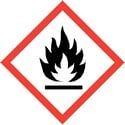Halfords Guide Coat 400ml
Applying a thin layer of black sanding aid before sanding clearly shows areas that have not been sanded smooth, identifying leftover sanding marks and low spots at an early stage which are normally only visible once the colour paint/ lacquer coat is applied.
INSTRUCTIONS FOR USE:
A safety ring is fitted to prevent accidental spraying. Remove nozzle and remove the coloured ring with a blunt screwdriver ensuring you do not damage the metal valve. Face the spray head away from you and replace nozzle. (CAUTION: Paint may spray out of the nozzle)
Refer to the icons for quick instructions, working temperature, drying times etc.
For best results ensure the can is at room temperature before use.
Avoid spraying in direct sunshine, cold, damp, humid or windy weather.
Recommended ambient temperature whilst painting +10° to + 25°C.
After use, turn the can upside down and spray for around 3-5 seconds to clear the nozzle and prevent blockages when used next.
Ensure you read the complete instructions and familiarise yourself with each step.
Ensure you have all consumables needed to hand before starting the process.
Once the filler or primer has been applied as per that products instructions and left to fully harden, shake the guide coat can for 2 minutes once the agitator ball inside is heard. Apply a single, very thin coat by pressing the nozzle and moving the can in a smooth side-to-side motion at a quicker speed than if you were using normal paint.
Only a thin dusing of the panel is required, adding a heavy layer will use more guide coat and take longer to remove.
When sanding filler
Work up in stages from P80, P180, P320 to a final P500 sand to remove the previous sanding marks in that process. apply the sanding aid every time you move up to the next stage of abrasive paper. Only move to the next stage once all of the sanding marks are removed.
When sanding primer
Repeat the steps above, however start with P500/P600 and move to a P800 before painting the colour coat.
CAUTIONS
*The drying time can change depending on the ambient temperature, humidity and the thickness of the coats applied. Ensure the paint is fully dry before attempting to sand.
Take care when preparing older paint surfaces (Pre 1970) as these may contain harmful Lead.
Ensure ventilation is adequate in the area you are painting in to prevent harmful build-up of solvent gasses.
DANGER
Extremely flammable aerosol. Pressurised container: May burst if heated. Causes serious eye irritation. May cause drowsiness or dizziness. Repeated exposure may cause skin dryness or cracking. Warning! Hazardous respirable droplets may be formed when sprayed. Do not breathe spray or mist. Buildup of explosive mixtures possible without sufficient ventilation. Keep out of reach of children. Keep away from heat, hot surfaces, sparks, open flames and other ignition sources. No smoking. Protect from sunlight. Do not expose to temperatures exceeding 50 °C/122 °F. Do not spray on an open flame or other ignition source. Do not pierce or burn, even after use. Do not breathe spray. If medical advice is needed, have product container or label at hand. Dispose of contents / container in accordance with regional regulations.






